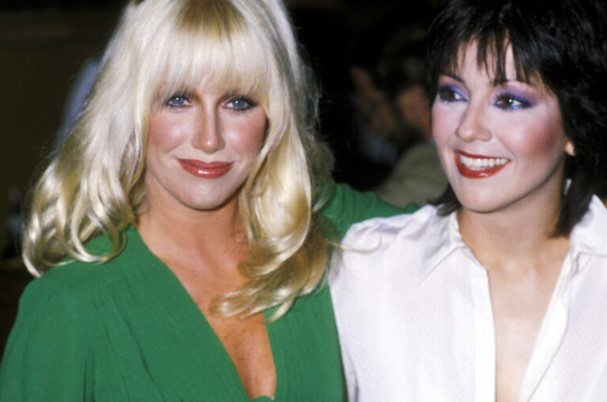
Decades may have passed since Three’s Company graced our screens, but its laughter still echoes in our hearts.
With unforgettable characters and side-splitting misunderstandings, this classic sitcom revolutionized the genre. Now, Joyce DeWitt reveals what really made the show a timeless treasure…
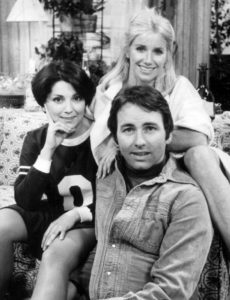
Public Domain
From the hilarious antics of three single roommates to the unforgettable performances of John Ritter and Suzanne Somers, Three’s Company remains a beloved staple of American television. It’s hard to believe it’s been 40 years since the series finale aired on ABC, yet its charm and humor still resonate today.
To illustrate how long ago Three’s Company became a hit, I just watched the intro. Seeing the shots from Santa Monica Pier during the show’s prime reminds me of how much has changed since they filmed there.
Sadly, neither John Ritter nor Suzanne Somers are with us anymore; both were taken from us far too soon. But keeping the spirit of Three’s Company alive is Joyce DeWitt, 75, who shares her vibrant stories and cherished memories from the beloved show.
”The most dear, precious, tender – and utterly unexpected – experiences that have come from working in ‘Three’s Company’ are the many, many adults who have told me that ‘Three’s Company’ was a safe haven they could count on during their teen years – for some, the only safe haven,” Joyce DeWitt told US Weekly.

Joyce DeWitt circa 1978. (Photo by Images Press/IMAGES/Getty Images)
Starring as Janet Wood alongside John Ritter and Suzanne Somers, DeWitt became a television icon and she was such a day brightener for millions.
She appeared in 171 episodes of the show between 1976 and 1984.
“It was such a gift. I mean, it was iconic. But who would have thought it?” Joyce DeWitt told The Spec. “All we were trying to do was make people laugh. When I think about it, the show was really an attempt to do a contemporary version of a 16th-century farce. It was about silliness running wild. I mean, we were talking about serious issues at times, but that was always somewhere underneath.”
“John Ritter used to say, ‘We don’t want people to just laugh but to fall over their couch laughing,’” she added. “The real issue was always the depth of friendship and the love those characters had for each other. That’s what drew people to them.”

Flickr
After Three’s Company ended, DeWitt stepped away from the spotlight for over a decade before making her comeback to acting.
Yet, no matter what she has accomplished or plans to do in the future, the vast majority will always connect her with that iconic show. And there’s a very simple reason for that, according to DeWitt.
“It was a ‘time out’ from the oppressive, challenging, difficult circumstances they were navigating in their young lives,” DeWitt says and adds:
“And, oh by the way, they say the characters also did stupid, crazy stuff that made them laugh. But it was the love, trust and support of the characters, one to the other, that made them lifelong fans.”

Public Domain
When you look at unedited photos from the Three’s Company set, the camaraderie among the cast shines through, especially in the images of Joyce DeWitt and Suzanne Somers, who played the beloved Chrissy Snow.
Both actresses delivered iconic performances, portraying young women navigating a male-dominated industry. They contributed just as much to the show’s success as John Ritter, and in those early days, their smiles in photos tell a story of friendship and collaboration.
Yet, beneath the laughter, tensions simmered. While Somers was celebrated for her role as “the dumbest blonde in America,” her fight for equal pay created rifts that would grow over time. As she demanded a 500% salary increase — from $30,000 to $150,000 — her relationship with DeWitt became strained. The set, once filled with joy, was now fraught with conflict.
Minha madrasta atrevida e seus 4 filhos adultos vestiram-se todos de branco no funeral do meu pai – todos ficaram boquiabertos quando ela tirou uma carta

Eu esperava que o funeral do meu pai fosse um dia de luto silencioso, um momento para homenagear o homem que manteve nossa família unida. O que eu não esperava era que minha madrasta transformasse isso em seu drama pessoal — até que uma carta do meu pai revelou segredos que deixaram ela e seus filhos humilhados na frente de todos.
O dia do funeral do meu pai já era um dos dias mais difíceis da minha vida. Eu mal consegui me conter para não desmoronar naquela manhã, sabendo que estava prestes a dizer adeus ao homem que manteve nossa família unida.

Mulher emocionada no funeral do pai | Fonte: Midjourney
Ele estava doente há muito tempo e, embora todos esperássemos que esse dia chegasse, nada me preparou para o peso sufocante que ele sentiria quando finalmente chegasse.
E então eles apareceram.
Vivian, minha madrasta, entrou valsando como se estivesse em uma passarela, seus quatro filhos adultos seguindo atrás dela, todos vestidos de branco. Branco gritante e forte — como se tivessem se perdido no caminho para uma festa chique em um iate.
Todos os outros estavam vestidos de preto, cabeças abaixadas, sofrendo. Mas eles não. Não, eles entraram como se estivessem participando de algum evento exclusivo, virando cabeças por todos os motivos errados.
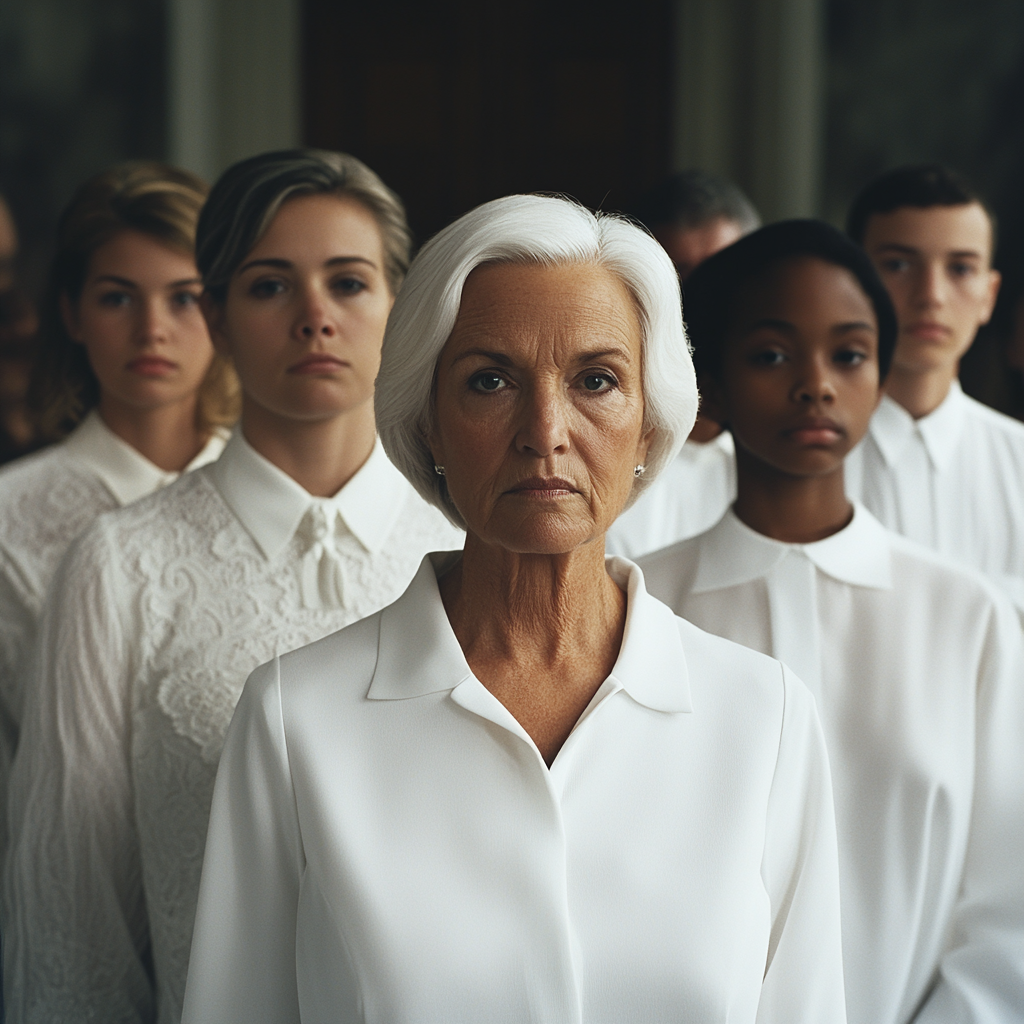
Mulher idosa e seus filhos vestidos de branco em um funeral | Fonte: Midjouney
Eu não conseguia acreditar no que estava vendo. Meu peito apertou de raiva enquanto eu empurrava a multidão e ia direto para ela.
“Vivian”, eu rebati, minha voz baixa, mas afiada o suficiente para cortar os murmúrios suaves ao nosso redor, “o que diabos você está fazendo? Por que você está vestida assim—” Eu gesticulei freneticamente para seu vestido branco esvoaçante e as roupas combinando de seus filhos, “—assim no funeral do meu pai?”
Ela nem sequer vacilou. Em vez disso, ela me deu esse sorriso preguiçoso e condescendente que só fez meu sangue ferver mais.
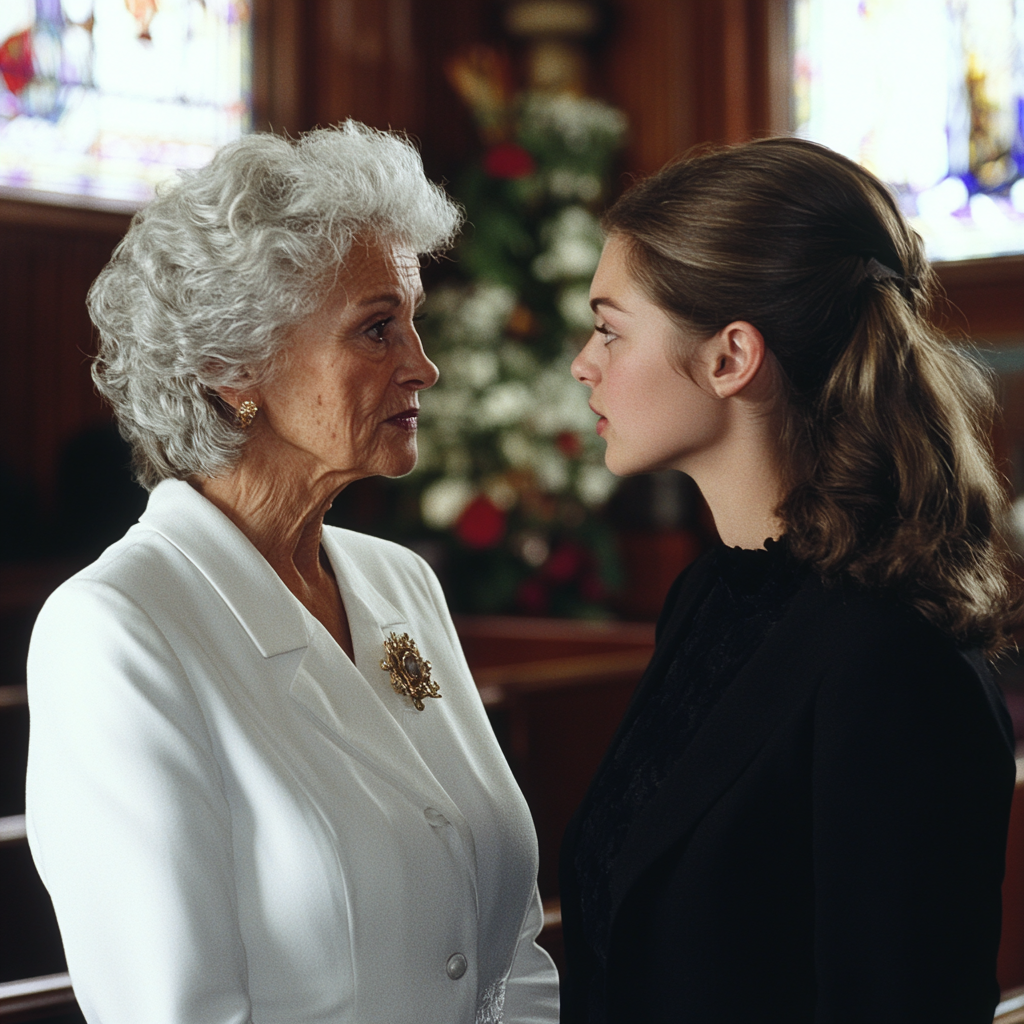
Mulher idosa e jovem conversando em um funeral | Fonte: Midjourney
“Oh, querida”, ela disse, arrastando as palavras como se eu fosse uma criança fazendo birra. “Não fique toda agitada. Seu pai queria isso.”
“Queria isso?”, repeti, minha voz aumentando apesar dos meus melhores esforços para manter a calma. “Não tem como o papai ter—”
Ela me interrompeu, pegando sua bolsa de grife e tirando um envelope cuidadosamente dobrado. “Ele me escreveu uma carta”, ela disse, segurando-a como se explicasse tudo. “Disse-me: ‘Vivian, você e as crianças devem usar branco. É meu último desejo.’”

Mulher idosa segurando um envelope | Fonte: Midjouney
Olhei para a carta na mão dela, sentindo os olhares de todos ao redor. Sussurros já estavam começando a se espalhar pela multidão.
“Não”, eu disse, balançando a cabeça. “Não tem como ele—”
“Ele fez, querida,” ela interrompeu com um suspiro, seus olhos brilhando como se ela estivesse gostando da cena. “Ele me disse que seria algo especial. Você deveria ser grata por estarmos honrando os desejos dele.”
Eu podia ouvir as pessoas ofegantes atrás de mim, a tensão na sala aumentando a cada segundo que passava.
“Você está falando sério?”, perguntei, minha voz tremendo agora. “Você realmente espera que eu acredite que papai queria isso — transformar seu funeral em algum… espetáculo?”
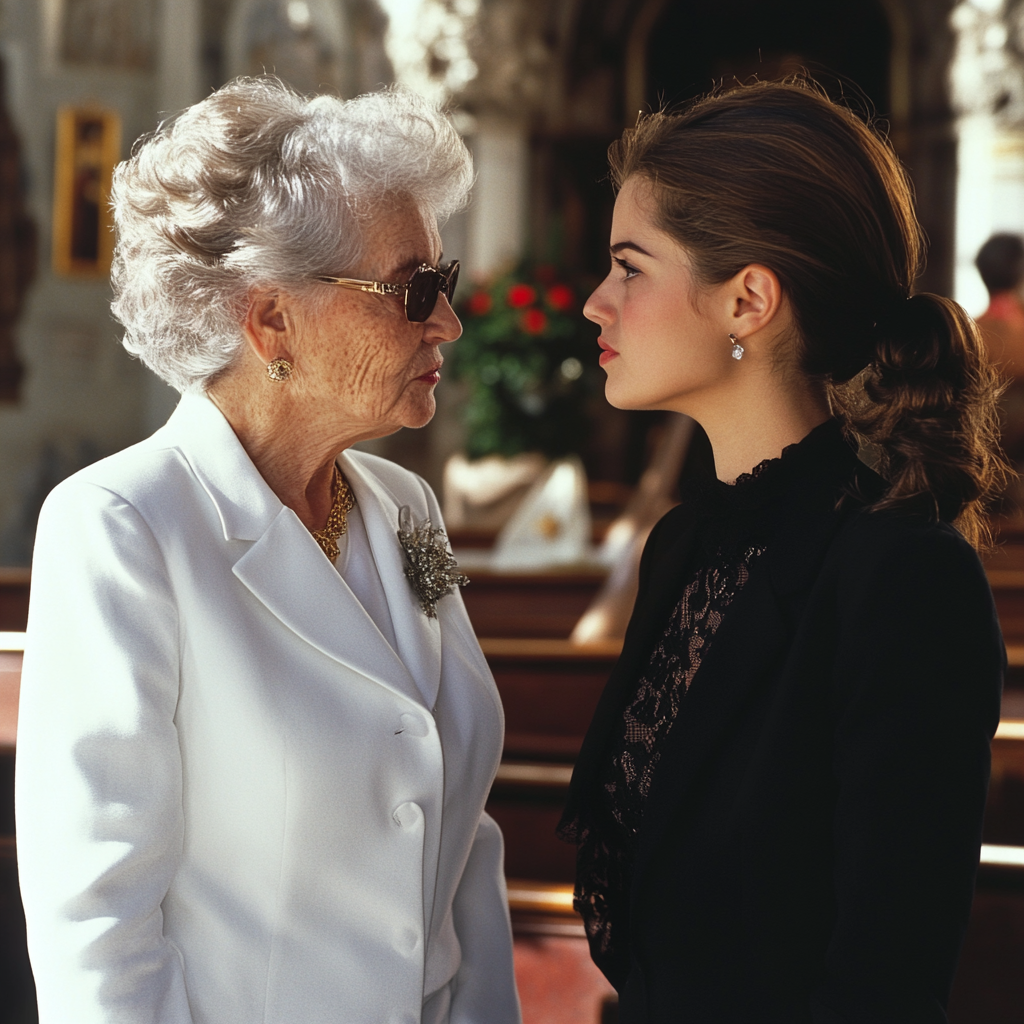
Mulher idosa e jovem conversando em um funeral | Fonte: Midjourney
Vivian deu de ombros, guardando a carta de volta na bolsa. “Acredite no que quiser”, ela disse friamente, “mas estamos apenas seguindo suas instruções finais. É o que ele queria.”
Eu podia sentir minhas mãos tremendo, a raiva borbulhando dentro de mim, mas antes que eu pudesse dizer outra palavra, ela se virou para as crianças e disse: “Vamos, vamos sentar. Não queremos nos atrasar.”
Fiquei ali, sem palavras, enquanto eles caminhavam em direção à primeira fila, me deixando fervendo em uma tempestade de confusão e fúria.

Jovem triste em um funeral | Fonte: Midjourney
A cerimônia começou, e, com certeza, ela e seus filhos tomaram seus lugares na primeira fila, vestidos como se fossem VIPs em alguma gala chique. Eles absorveram a atenção, suas roupas brancas praticamente brilhando contra o pano de fundo dos enlutados vestidos de preto.
Justo quando eu pensava que não conseguiria mais lidar com a arrogância deles, Joe, o melhor amigo do meu pai, apareceu na frente. Seu rosto estava tenso de emoção, os olhos pesados de tristeza, mas havia algo mais ali também — uma tensão que fez meu estômago revirar.

Homem idoso fazendo discurso em funeral | Fonte: Midjourney
Ele limpou a garganta, a sala ficou completamente silenciosa enquanto todos viravam o olhar para ele. Em sua mão, ele segurava uma carta.
“Vivian”, ele disse, sua voz firme, mas calma. Ele gesticulou para que ela se levantasse, e eu pude ver o menor indício de um sorriso irônico em seus lábios. Ela se levantou lentamente, seu queixo erguido como se estivesse prestes a receber um prêmio. Seus filhos a seguiram, ficando ao lado dela com olhares presunçosos.
“Esta carta…”, Joe começou, com a voz ligeiramente trêmula, “foi escrita pelo seu marido.”
A voz de Joe estava firme quando ele começou a ler a carta, e a sala inteira pareceu prender a respiração.

Homem idoso lendo uma carta em um funeral | Fonte: Midjourney
“Aos meus queridos amigos e familiares”, Joe leu, sua voz carregada de emoção. “Quero agradecer a todos por estarem aqui hoje, por honrarem minha memória. Há algo que preciso abordar, algo que está pesando em meu coração.”
Olhei para Vivian. Sua expressão, antes presunçosa e superior, começou a mudar. Um lampejo de desconforto surgiu em seus olhos enquanto ela se endireitava, seu olhar disparando nervosamente ao redor da sala.

Mulher idosa usando um vestido branco em um funeral | Fonte: Midjourney
Joe continuou: “Não pude deixar de notar que, durante minha doença, minha ex-esposa, Martha, foi quem cuidou de mim. Ela estava lá quando eu mais precisei de alguém, enquanto Vivian e seus filhos estavam sempre ausentes — a menos, é claro, que precisassem de algo de mim.”
O rosto de Vivian perdeu a cor. Ela ficou rígida, congelada como se quisesse desaparecer.
Seus filhos, que estavam sentados confiantes, agora estavam nervosos, com os olhos arregalados de medo.
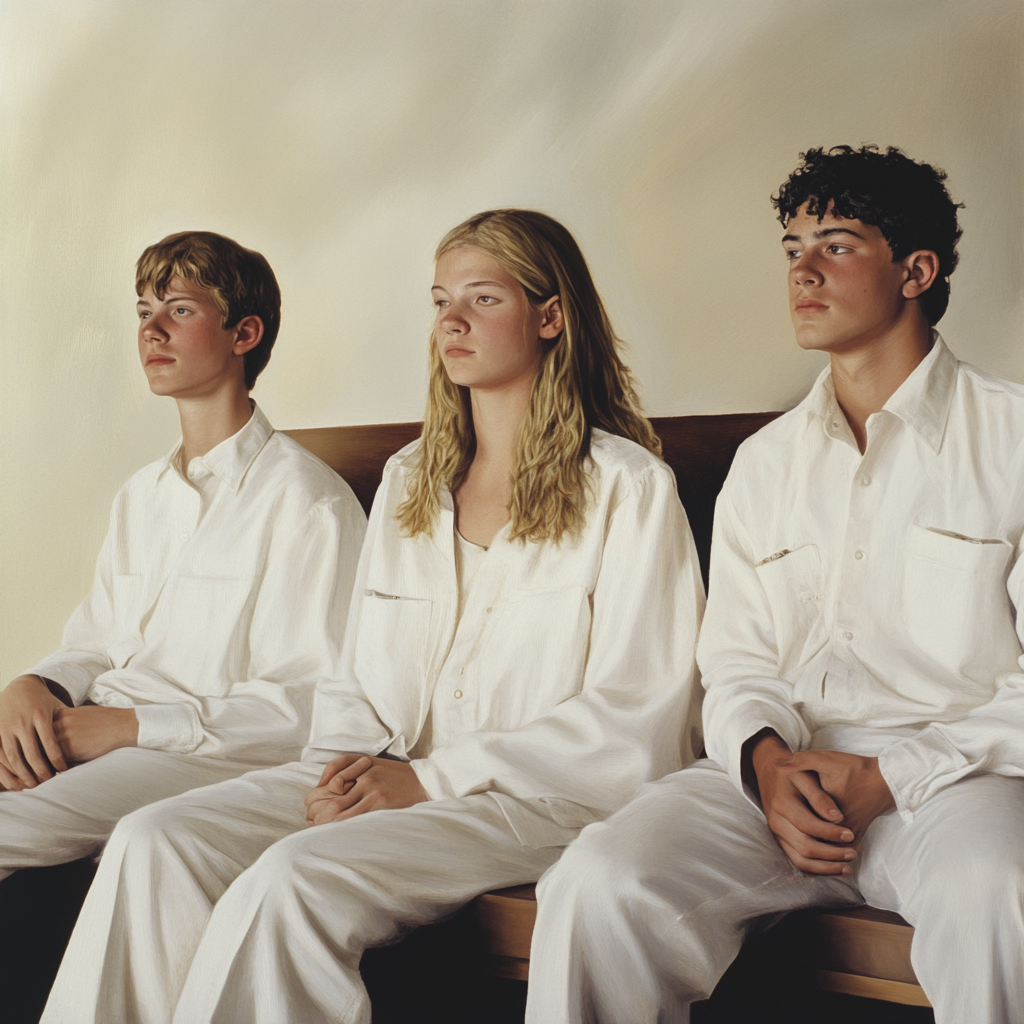
Jovens adultos vestindo branco em um funeral | Fonte: Midjourney
Murmúrios percorreram a multidão como uma onda, e pude ver as pessoas trocando olhares chocados.
“Isso não é verdade!” Vivian sussurrou de repente, mas sua voz falhou, traindo seu medo.
Joe mal fez uma pausa. “Ficou claro para mim que minha nova família estava mais interessada no que eu poderia fornecer do que em quem eu era. E então”, ele olhou incisivamente para Vivian, “eu descobri, através do meu consultor financeiro, que dinheiro estava desaparecendo das minhas contas. Nós investigamos e descobrimos que Vivian e seus filhos estavam por trás disso.”

Homem idoso lendo uma carta em um funeral | Fonte: Midjourney
Um suspiro coletivo encheu a sala. Parecia que as próprias paredes tremeram com o som. Os filhos de Vivian, que estavam sentados tão confiantes, agora pareciam pálidos como fantasmas, enquanto os olhos de cada convidado se fixavam neles.
O rosto de Vivian se contorceu de raiva, sua máscara de calma se despedaçando completamente. “Isso é mentira!” ela gritou, sua voz tremendo de fúria. “Uma invenção completa! Você não pode acreditar nesse lixo!”
Ela cerrou os punhos enquanto olhava freneticamente ao redor da sala, como se procurasse alguém para intervir e defendê-la.
Mas ninguém falou. O silêncio era ensurdecedor.
O olhar de Joe não vacilou. Ele levantou a carta novamente e continuou, sua voz inabalável.

Homem idoso lendo uma carta em um funeral | Fonte: Midjourney
“Eu sabia que eles viriam ao meu funeral, esperando desempenhar o papel da família enlutada. Então, pedi que eles vestissem branco. Eu queria que eles se destacassem, para que todos pudessem vê-los como eles são.”
Vivian arfou, seus olhos arregalados de descrença. “Seu bastardo,” ela cuspiu, sua voz tremendo com raiva venenosa. “Você acha que pode me humilhar na frente de todo mundo assim? Você vai se arrepender disso! Vocês todos vão!”
Mas Joe não parou. Sua voz soou alta e clara, cortando sua raiva como uma lâmina. “Vivian, você e seus filhos não são mais bem-vindos aqui. Este é um lugar para aqueles que me amavam pelo que eu era, não pelo que eu poderia dar a eles. Por favor, vá embora, e deixe minha verdadeira família e amigos chorarem em paz.”

Homem idoso lendo uma carta em um funeral | Fonte: Midjourney
O silêncio era sufocante. Todos os olhos na sala estavam fixos em Vivian e seus filhos, esperando o próximo movimento. Seu rosto era um turbilhão caótico de emoções — choque, raiva, humilhação. Por uma fração de segundo, pareceu que ela poderia explodir, seus olhos selvagens de fúria.
Mas então, ela olhou ao redor e viu os rostos dos convidados — olhares frios e implacáveis. O peso do julgamento a pressionou, e qualquer luta que lhe restasse se esvaiu.

Multidão em um funeral | Fonte: Midjourney
Seus filhos, antes tão cheios de confiança presunçosa, encolheram-se diante do escrutínio, com os olhos fixos no chão, como se pudessem desaparecer nele.
Vivian bufou alto, seus lábios se curvando em desgosto. “Tudo bem! Essa coisa toda é uma farsa de qualquer maneira”, ela cuspiu, arrancando sua bolsa da cadeira. Sua voz pingava veneno, mas todos podiam ver que ela estava encurralada. Derrotada. “Vamos lá”, ela gritou para seus filhos, sua voz afiada como vidro quebrado.
Vivian correu em direção à saída, seus saltos batendo no chão com uma fúria que não conseguia esconder sua humilhação.
Ela estava acabada e sabia disso.

Mulher idosa saindo de um funeral | Fonte: Midjouney
A porta bateu atrás deles, deixando um silêncio espesso em seu rastro. Ninguém se moveu por um longo momento, como se o quarto estivesse exalando após a tempestade.
Joe calmamente dobrou a carta, seus olhos examinando a sala com uma expressão sombria. “Agora”, ele disse, sua voz firme, “vamos continuar lembrando do homem que realmente merece ser homenageado hoje.”
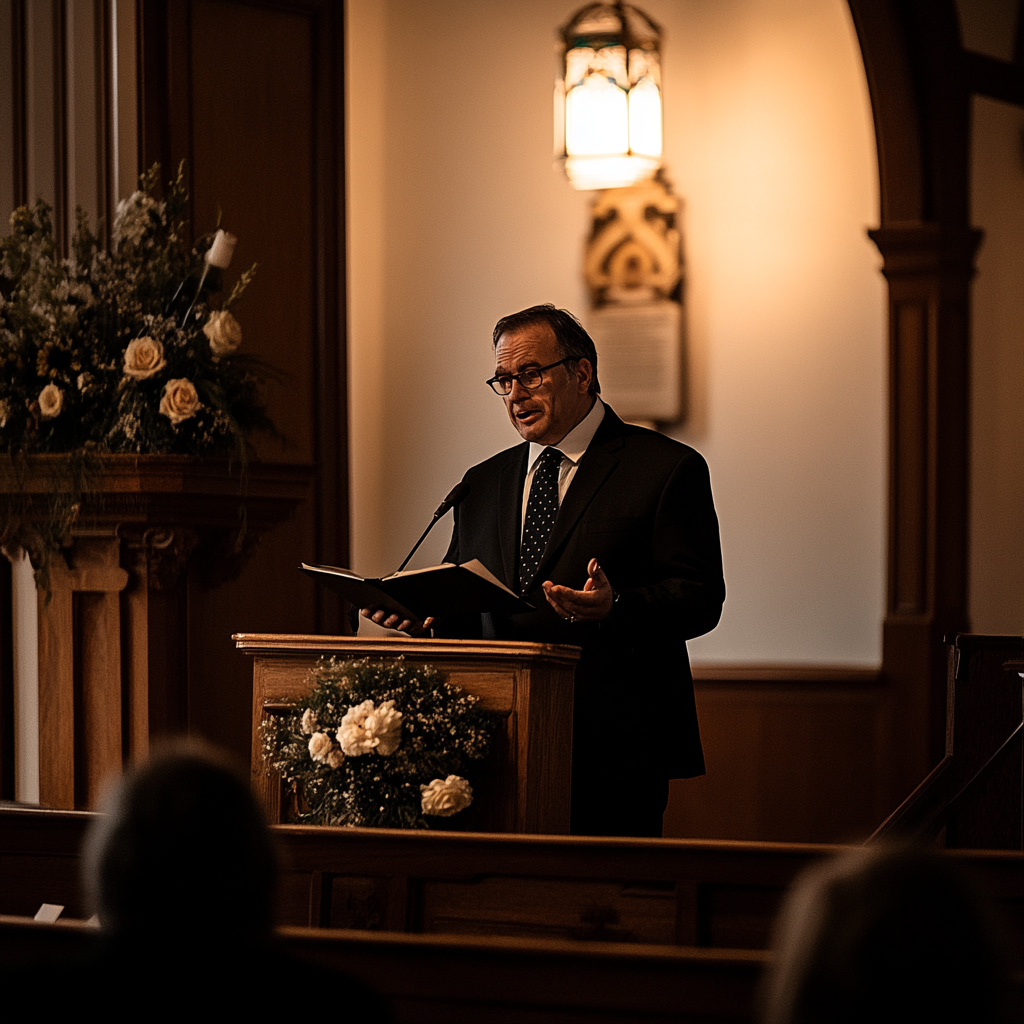
Homem idoso fazendo discurso em funeral | Fonte: Midjourney
E assim fizemos. A cerimônia ocorreu pacificamente, uma celebração da vida do meu pai cercada pelas pessoas que o amaram pelo que ele era. Nós rimos, choramos e compartilhamos histórias que capturaram a essência do homem que nos uniu.
Quanto a Vivian? Ela teve exatamente o que merecia — uma saída envolta em vergonha e desgraça. Meu pai, mesmo na morte, riu por último. Ele os expôs, desfez suas pretensões e garantiu que a verdade viesse à tona no final.

Foto em close de um caixão | Fonte: Midjourney
Meu pai pode ter partido, mas sua sabedoria — seu senso de justiça — estava vivo e bem. E enquanto eu ouvia Joe contar uma história engraçada sobre meu pai, uma coisa ficou clara.
“Papai sempre soube escolher seus momentos”, sussurrei.

Jovem no funeral do pai | Fonte: Midjourney
Se você gostou desta história, aqui vai outra que vai chamar sua atenção: Minha madrasta me fez dormir em um galpão e deu meu quarto para os filhos dela — minha mãe imediatamente a trouxe de volta à Terra. Clique aqui para ler a história completa.
Este trabalho é inspirado em eventos e pessoas reais, mas foi ficcionalizado para fins criativos. Nomes, personagens e detalhes foram alterados para proteger a privacidade e melhorar a narrativa. Qualquer semelhança com pessoas reais, vivas ou mortas, ou eventos reais é mera coincidência e não intencional do autor.
O autor e a editora não fazem nenhuma reivindicação quanto à precisão dos eventos ou à representação dos personagens e não são responsáveis por nenhuma interpretação errônea. Esta história é fornecida “como está”, e quaisquer opiniões expressas são as dos personagens e não refletem as opiniões do autor ou da editora.
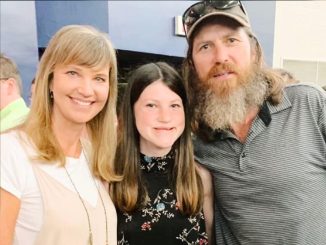


Leave a Reply